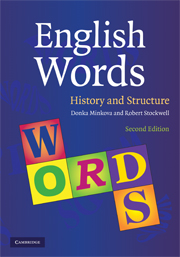Book contents
- Frontmatter
- Contents
- Preface to the second edition and acknowledgements
- An introduction to the textbook
- 1 Word-origins
- 2 The background of English
- 3 Composition of the Early Modern and Modern English Vocabulary
- 4 Smaller than words: morphemes and types of morphemes
- 5 Allomorphy, phonetics, and affixation
- 6 Replacement rules
- 7 Deletion rules and other kinds of allomorphy
- 8 Fossilized allomorphy: false cognates and other etymological pitfalls
- 9 Semantic relations and semantic change
- 10 The pronunciation of classical words in English
- Appendix: morpheme list
- Index
- References
9 - Semantic relations and semantic change
Published online by Cambridge University Press: 05 June 2012
- Frontmatter
- Contents
- Preface to the second edition and acknowledgements
- An introduction to the textbook
- 1 Word-origins
- 2 The background of English
- 3 Composition of the Early Modern and Modern English Vocabulary
- 4 Smaller than words: morphemes and types of morphemes
- 5 Allomorphy, phonetics, and affixation
- 6 Replacement rules
- 7 Deletion rules and other kinds of allomorphy
- 8 Fossilized allomorphy: false cognates and other etymological pitfalls
- 9 Semantic relations and semantic change
- 10 The pronunciation of classical words in English
- Appendix: morpheme list
- Index
- References
Summary
Introduction and terminology
The meanings of words, and semantic analysis generally, can be discussed in terms of sense variation around a common core, and in terms of the kinds of affinities and contrasts we can discern between meanings.
Sense variation: homophony, homonymy, polysemy
In Chapter 8 we listed and commented on some roots and affixes that can easily be confused. We dealt with them under the umbrella of the neutral term homophony (‘sounding the same’). All of the pairs below count as homophones:
chair: to sit on vs. chair of a department
corn: grain, seed vs. corn on toe
crane: a bird vs. crane a machine
ear: of corn vs. ear organ of hearing
load: of dirt vs. lode in a gold mine
meal: ground up vs. meal at dinner time
mettle: in the sense of courage vs. metal in the sense of iron, copper
pupil: of your eye vs. pupil a student
score: a notch, vs. score a game result, vs. score a group of twenty
sea: body of water vs. see verb of perception
seal: aquatic mammal vs. seal a device for making imprints
sole: fish vs. sole only vs. sole of a shoe, vs. soul in a religious sense
trip: journey vs. trip to obstruct, cause to fall
waist: of a person vs. waste squander
The term homophony, useful as it is, bundles together words of the type chair (to sit on) – chair (of a department) and corn (on the cob) – corn (on toe).
- Type
- Chapter
- Information
- English WordsHistory and Structure, pp. 163 - 181Publisher: Cambridge University PressPrint publication year: 2009

